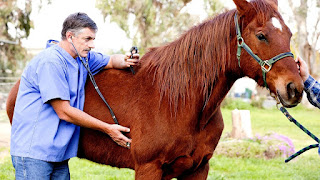Robert Zakar gives back to community
Neurologic Herpesvirus In Alberta Horse
A horse at a private facility in Athabasca County, Alberta, is positive for neurologic equine herpesvirus. The horse first developed respiratory symptoms, including cough and nasal discharge. It then developed acute neurological disease with hind-end ataxia, urine dribbling and fecal retention. The horse is under voluntary quarantine and is now recovering.
EDCC Health Watch is an Equine Network marketing program that utilizes information from the Equine Disease Communication Center (EDCC) to create and disseminate verified equine disease reports. The EDCC is an independent nonprofit organization that is supported by industry donations in order to provide open access to infectious disease information.
Herpesvirus is highly contagious among horses and can cause a variety of ailments in equids, including rhinopneumonitis (a respiratory disease usually found in young horses), abortion in broodmares and EHM.
In many horses, the first or only sign of EHV-1 infection is fever, which can go undetected. In addition to fever, other common signs of EHV-1 infection in young horses include cough, decreased appetite, depression and a nasal discharge. Pregnant mares typically show no signs of infection before they abort, and abortions usually occur late in gestation (around eight months) but can be earlier. Abortions can occur anywhere from two weeks to several months following infection with EHV-1.
Horses with EHM usually have a fever at the onset of the disease and might show signs of a respiratory infection. A few days later, neurologic signs such as ataxia (incoordination), weakness or paralysis of the fore- and hind limbs, urine retention and dribbling, loss of tail tone and recumbency (inability to rise) develop.
Herpesvirus is easily spread by nose-to-nose or close contact with an infectious horse; sharing contaminated equipment including bits, buckets and towels; or clothing, hands or equipment of people who have recently had contact with an infectious horse. Routine biosecurity measures, including hygiene and basic cleaning and disinfection practices, should be in place at all times to help prevent disease spread.
Current EHV-1 vaccines might reduce viral shedding but are not protective against the neurologic form of the disease. Implementing routine biosecurity practices is the best way to minimize viral spread, and the best method of disease control is disease prevention.
Horses Reunite With Riders As Wellspring Farm Reopens After Virus Outbreak And Quarantine
delawareonline.Com cannot provide a good user experience to your browser. To use this site and continue to benefit from our journalism and site features, please upgrade to the latest version of Chrome, Edge, Firefox or Safari.
Department Of Agriculture Issues Warning After Virus Detected In Horse At Expo Square Show
ERROR: The request could not be satisfiedRequest blocked. We can't connect to the server for this app or website at this time. There might be too much traffic or a configuration error. Try again later, or contact the app or website owner. If you provide content to customers through CloudFront, you can find steps to troubleshoot and help prevent this error by reviewing the CloudFront documentation.
Generated by cloudfront (CloudFront) Request ID: 3foG-PcwOFwOBqM_zyiMHZETN2Pkt4sOWGDYArjoJKdFJrlXov_QzA==


Comments
Post a Comment